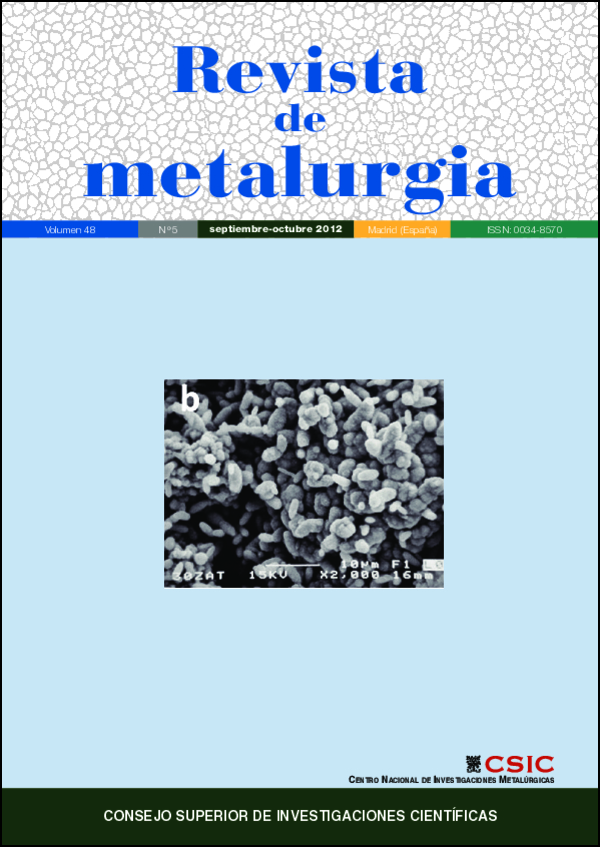Study of sulphate-reducing bacteria corrosion in the weld joint for API X-70 steel
DOI:
https://doi.org/10.3989/revmetalm.1157Keywords:
Corrosion, API X-70, HAZ, Sulphate-reducing-bacteria, MICAbstract
The corrosion behavior originated by sulfate-reducing bacteria (SRB) was studied in two regions of welded API X-70 steel pipeline. The studies were focused on base material (BM) and heat affected zone (HAZ), from the internal region of the pipe. SRB were extracted from oil and grown in a Postgate medium. Corrosion was evaluated at 60 °C for times between 5 and 64 days. Potentiodynamic polarization curves, obtained by electrochemical techniques, indicated surface activation at short times. Structural and morphological characterizations were carried out by scanning electron microscopy (SEM) and optical microscopy (OM). H2S concentration and pH were also measured. Results showed an important increase in the corrosion damage up to 20 days, influenced by the SRB activity, which lead to a maximum of H2S (pH minimum). It was found a localized corrosion attack in the HAZ in a higher quantity compared to BM; and the formation of a thin film on the steel surface, originated by corrosion products and bacterial activity.
Downloads
References
[1] R. P. George, D. Marshall and R. C. Newman, Corros. Sci. 45 (2003) 1999-2015. http://dx.doi.org/10.1016/S0010-938X(03)00028-3
[2] J. Luo and I. Vance, Proc. "Corrosion",Houston TX, NACE, paper 265, 1994, pp. 2-4.
[3] R. Javaherdashti, Anti-Corros. Method M. 46 (1999) 173-180. http://dx.doi.org/10.1108/00035599910273142
[4] R. Torres-Sánchez, J. García-Vargas, A. Alfonso-Alonso and L. Martínez-Gómez, Mater. Corros. 52 (2001) 614-618. http://dx.doi.org/10.1002/1521-4176(200108)52:8<614::AID-MACO614>3.0.CO;2-G
[5] A. K. Lee, M. G. Buehler and D. K. Newman, Corros. Sci. 48 (2006) 165-178. http://dx.doi.org/10.1016/j.corsci.2004.11.013
[6] D. H. Pope, Proc. "Corrosion", Houston. TX, NACE, paper 265, 2000, pp. 2-4.
[7] M. Rodríguez-Hernández, R. Galván-Martínez, R. Orozco-Cruz, E. A. Martínez and R. Torres-Sánchez, Mater. Corros. 60 (2009) 982-986. http://dx.doi.org/10.1002/maco.200905221
[8] J. W. Costerton, G. G. Geesey and P. A. Jones., Proc. "Corrosion", San Francisco, CA, NACE, paper 54, 1987.
[9] P. Nelson and J. R. Stile, Met. Mater. 9 (1988) 559-564.
[10] R. E. Tatnall, A Practical Manual on Microbiologically Influenced Corrosion, Ed. G. Kobrin, NACE International, Houston, Tex., 1993, pp. 101-112.
[11] L. Garverick,Corrosion in the petrochemical industry, ASM International, Metals Park, 1994, p. 23.
[12] M. Ronald, Handbook of Microbiological Media, Ed. by Lawrence C. Parks, 1996, 746.
[13] M. Ruscak and T. P. Perng., J. Mater. Sci. Technol. 1 (1993) pp. 1-5.
[14] V. A. Alves, A. M., Chiorcea Paquim, A. Cavaleiro and C. M. A. Brett., Corros. Sci. 47 (2005) 2871-2882. http://dx.doi.org/10.1016/j.corsci.2005.05.038
[15] H. An-Guo, L. Zhi-Yuan, Y. Sheng-Fu, Z. Long-Zao, Z. Guo-Dong, Trans China Weld Inst. 11 (2005) 123-126.
Downloads
Published
How to Cite
Issue
Section
License
Copyright (c) 2012 Consejo Superior de Investigaciones Científicas (CSIC)

This work is licensed under a Creative Commons Attribution 4.0 International License.
© CSIC. Manuscripts published in both the printed and online versions of this Journal are the property of Consejo Superior de Investigaciones Científicas, and quoting this source is a requirement for any partial or full reproduction.
All contents of this electronic edition, except where otherwise noted, are distributed under a “Creative Commons Attribution 4.0 International” (CC BY 4.0) License. You may read the basic information and the legal text of the license. The indication of the CC BY 4.0 License must be expressly stated in this way when necessary.
Self-archiving in repositories, personal webpages or similar, of any version other than the published by the Editor, is not allowed.
















